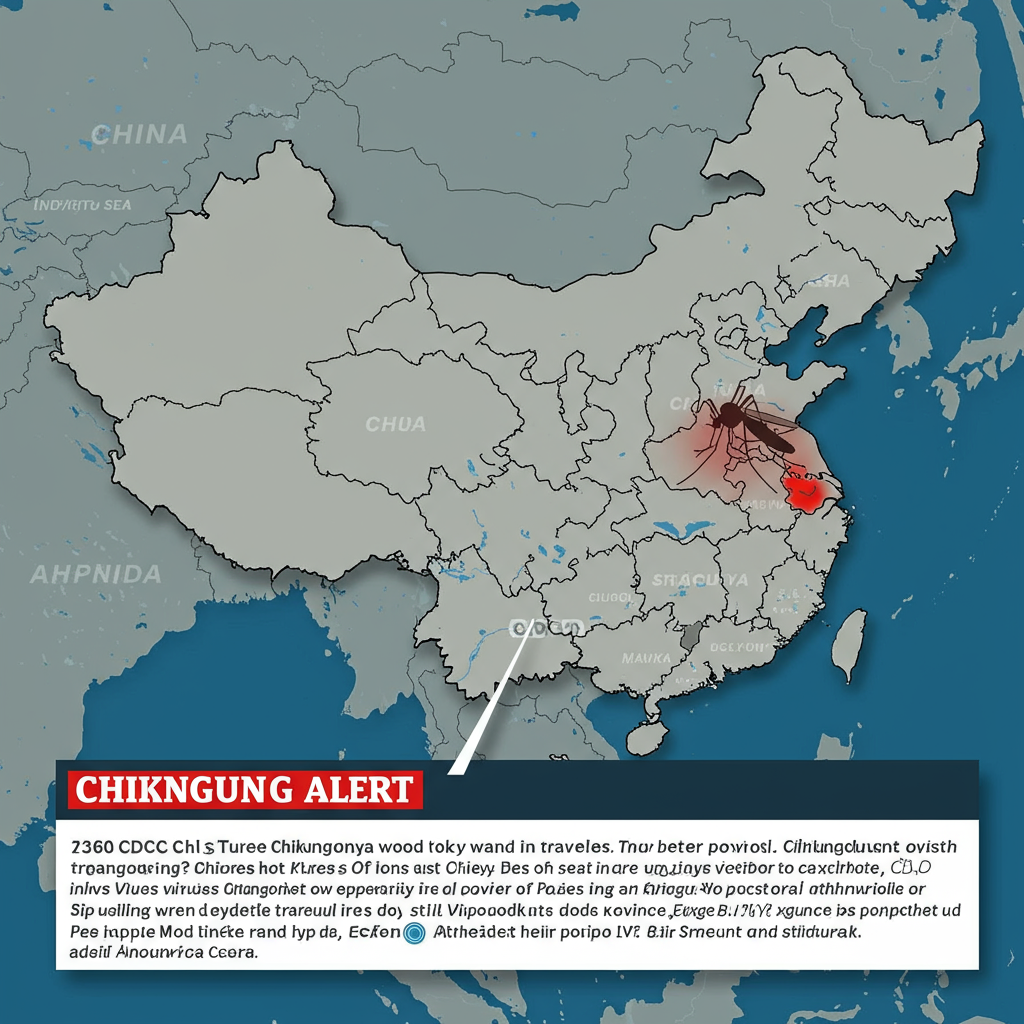The United States is closely monitoring a significant surge in chikungunya cases across China, particularly in Guangdong province. This escalating situation has prompted the U.S. Centers for Disease Control and Prevention (CDC) to consider issuing a travel health notice for China, alerting international travelers to the heightened risk of this mosquito-borne illness. With nearly 5,000 cases reported in China since early July, and almost 3,000 new infections in Guangdong province alone last week, understanding the virus and taking preventative measures is crucial for anyone planning to visit the region.
Understanding the Chikungunya Threat
Chikungunya is a viral disease primarily transmitted to humans through the bite of infected Aedes aegypti and Aedes albopictus mosquitoes. The name “chikungunya” originates from the Kimakonde language of southern Tanzania, roughly translating to “that which bends up,” a vivid description of one of its most debilitating symptoms: severe joint pain. This pain can be so intense that it causes infected individuals to stoop or appear folded over. The virus was first identified in Tanzania in the early 1950s and has since spread globally, impacting over 110 countries worldwide.
While fatalities from chikungunya are rare, the illness can lead to serious health effects. Symptoms typically include a sudden onset of fever and severe joint pain, often accompanied by muscle aches, headaches, joint swelling, and a rash. In some cases, particularly for older adults or those with compromised immune systems, the joint pain can persist for months or even result in long-term disability. Crucially, there is no specific antiviral medicine to treat chikungunya once infected, meaning treatment focuses entirely on managing symptoms with pain relief and rest. This lack of a cure underscores the vital importance of prevention.
The Alarming Outbreak in China
The current chikungunya outbreak in China is particularly alarming due to its rapid proliferation. The country has recorded nearly 5,000 cases since a single infection was identified in early July. Guangdong province, located near Hong Kong, has become the epicenter, accounting for almost 3,000 cases in the past seven days alone. The initial case that triggered this outbreak was reportedly imported into Shunde, a district within Foshan in Guangdong.
In response to the escalating crisis, public health officials in Guangdong have initiated aggressive eradication efforts aimed at controlling the virus’s spread. These proactive measures include deploying drones to identify and map areas of standing water, which serve as prime breeding grounds for virus-carrying mosquitoes. Additionally, local authorities have introduced fish that consume mosquito larvae into lakes and other water bodies, actively working to disrupt the mosquito life cycle. The CDC has confirmed its awareness of the outbreak and is actively assessing its size and extent, collaborating with local health officials to gauge the situation’s scope.
Global Implications and Rising Risk
The surge in chikungunya cases in China is part of a concerning global trend. Data from the European Centre for Disease Prevention and Control (ECDC) indicates that worldwide, the chikungunya virus has caused over 240,000 cases and at least 90 deaths across more than 16 countries this year alone. This widespread activity has prompted urgent calls for action from international health organizations.
The World Health Organization (WHO) has issued an urgent plea to prevent a recurrence of the chikungunya epidemic that swept the globe two decades ago. The WHO notes that new outbreaks, particularly those linked to the Indian Ocean region, have already spread to Europe and other continents. Diana Rojas Alvarez, a medical officer at the WHO, estimates that a staggering 5.6 billion people across 119 countries are currently at risk of contracting the virus. This vast number highlights the pervasive threat posed by chikungunya.
Factors contributing to the increased frequency and widespread nature of chikungunya outbreaks since 2004 are complex. Viral adaptations have made the virus more easily transmissible, while changes in global travel patterns facilitate its rapid spread across continents. A warming climate and the adaptation of carrier mosquitoes to urban environments also contribute significantly, making these vectors harder to control. The potential for infected travelers to disseminate the virus globally remains a significant concern, prompting agencies like the CDC to evaluate formal travel health notices.
Navigating Travel Risks: Essential CDC Guidance
The CDC’s role in this context is to issue travel health notices that inform individuals about necessary precautions when traveling amidst disease outbreaks or natural disasters. For travelers heading to affected regions like China, preventative measures against mosquito bites are the primary and most effective defense, given the absence of a specific chikungunya cure or vaccine.
The CDC strongly advises several precautions to minimize infection risk:
Use effective insect repellent: Choose repellents containing DEET, picaridin, oil of lemon eucalyptus, para-menthane-diol, or 2-undecanone. Always apply according to product instructions.
Wear protective clothing: Opt for long-sleeved shirts and long pants, especially during dawn and dusk, when mosquitoes are most active.
Choose screened accommodations: Stay in air-conditioned or screened-in environments whenever possible. Ensure windows and doors have intact screens to keep mosquitoes out.
Eliminate standing water: Assist in removing standing water from around your accommodation, as even small amounts can serve as mosquito breeding grounds. This includes flower pots, buckets, and discarded tires.
It’s important to remember that mosquitoes are vectors for numerous other serious diseases beyond chikungunya, including malaria, dengue fever, yellow fever, Zika, and West Nile virus. Therefore, adopting these preventative measures offers broader protection against a spectrum of mosquito-borne illnesses.
The Broader Mosquito-Borne Threat: Beyond Chikungunya
While chikungunya is currently a primary concern, it’s essential to understand that it is part of a larger, ongoing challenge posed by mosquito-borne diseases worldwide. For instance, the West Nile virus (WNV) also presents a significant threat, as evidenced by recent increases in cases and fatalities in Europe. Italy, for example, has reported ten deaths due to WNV since the beginning of the year, with a concerning 20% lethality rate for the neuro-invasive form of the virus in 2025.
Like chikungunya, WNV is primarily transmitted through mosquito bites, with wild birds being the main hosts. Most infected individuals remain asymptomatic or develop mild flu-like symptoms, but a small percentage can develop severe neurological illness. There is no specific treatment or vaccine for WNV, highlighting that prevention through mosquito bite avoidance remains the sole effective strategy across many of these diseases. This global landscape underscores the critical need for continued vigilance and robust public health responses to vector-borne threats.
Future Outlook and Collective Action
As the chikungunya virus continues its expansion globally, including its significant presence in China, sustained focus and collective action are crucial to mitigate its impact. Both the CDC and WHO are taking coordinated action, working with officials in China and other affected regions to track the virus’s spread and mitigate risks. This includes reinforcing preventative measures such as mosquito control efforts, public awareness campaigns, and strengthening local health systems to manage outbreaks effectively.
For individuals, staying informed about the latest health advisories and travel restrictions is paramount. While not yet a global epidemic in the broadest sense, the current outbreak carries that risk. Therefore, both travelers to affected countries and health officials must prioritize preventative measures. Taking personal precautions against mosquito bites and diligently monitoring health notices complements the containment efforts of leading organizations. Vigilance and proactive steps are key to preventing a widespread global health crisis.
Frequently Asked Questions
What exactly is chikungunya and why is it concerning now?
Chikungunya is a viral disease transmitted by mosquito bites, causing symptoms like fever and severe joint pain, which can be debilitating and long-lasting. It’s concerning now due to a rapid surge in cases, particularly in China’s Guangdong province, with nearly 5,000 cases reported recently. This surge, combined with the lack of a specific cure and the virus’s potential to spread globally via infected travelers, has prompted the U.S. CDC to consider a travel warning and the WHO to express urgent concern about a potential global epidemic.
How can travelers to China or other affected regions protect themselves from chikungunya?
Travelers should prioritize preventing mosquito bites, as there’s no specific treatment for chikungunya. Key protective measures include using insect repellents containing DEET, picaridin, or oil of lemon eucalyptus. Wear long-sleeved shirts and pants, especially during peak mosquito activity at dawn and dusk. Choose air-conditioned or well-screened accommodations and help eliminate standing water around your living space, as these are mosquito breeding grounds. Staying informed about current health advisories is also crucial.
What should I do if I experience symptoms of chikungunya after traveling?
If you develop symptoms such as fever, severe joint pain, muscle aches, headaches, or a rash after returning from an area with chikungunya, seek medical attention immediately. Inform your healthcare provider about your recent travel history. While there’s no specific cure, treatment focuses on managing symptoms with rest and pain relievers. Early diagnosis can help in symptom management and in preventing further spread if you are still in an area with mosquitoes.




